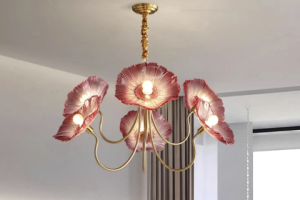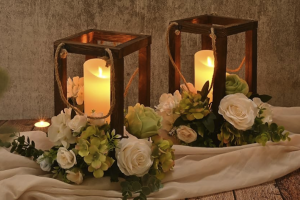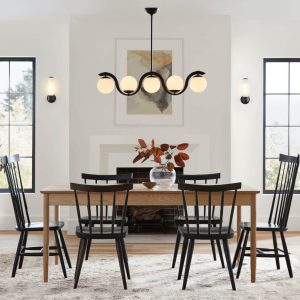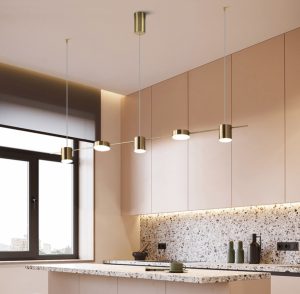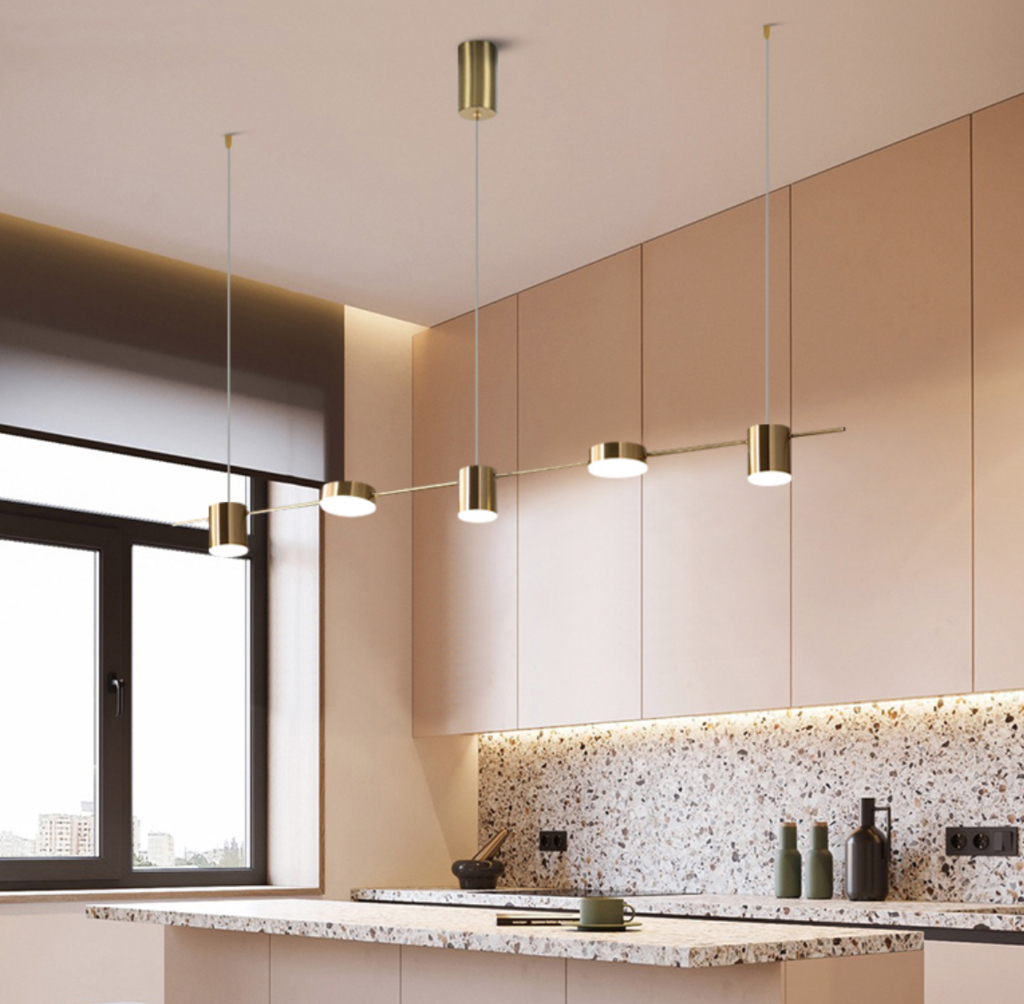
Pendant lighting is a type of lighting fixture that is suspended from the ceiling by a cord, chain, or metal rod. It typically consists of a single light source enclosed in a decorative shade or glass globe. Pendant lighting has been used for centuries as a stylish and versatile lighting solution for homes.yahiloo
The history of pendant lighting can be traced back to ancient civilizations such as the Egyptians and Greeks, who used hanging lamps made of clay or metal to provide light in their homes. Over time, pendant lighting evolved and became more ornate, with intricate designs and materials such as crystal and stained glass being used.
Today, pendant lighting is a popular choice for homeowners due to its ability to enhance the overall look and feel of a space. It can add a touch of elegance and sophistication to any room, while also providing functional lighting. Whether used as a statement piece in a grand foyer or as task lighting in a kitchen, pendant lighting offers endless possibilities for homeowners looking to elevate their home decor.
Key Takeaways
- Pendant lighting is a stylish and versatile lighting solution that can enhance the ambiance and functionality of any room in your home.
- There are different styles of pendant lighting to choose from, so you can find the perfect design for your home.
- Pendant lighting can be used in every room of your home, from the kitchen to the bedroom, and can even be used to maximize lighting potential in small spaces.
- For larger spaces, pendant lighting can create a statement piece in your home.
- Installing pendant lighting is a DIY-friendly project, and choosing the right bulbs can maximize energy efficiency and style.
The Benefits of Pendant Lighting: Enhancing Your Home’s Ambience and Functionality
One of the main benefits of pendant lighting is its ability to improve the overall look and feel of your home. Pendant lights come in a wide variety of styles, sizes, and materials, allowing you to choose the perfect design that complements your home’s decor. Whether you prefer a modern and sleek look or a more traditional and ornate design, there is a pendant light out there for you.
In addition to enhancing your home’s ambience, pendant lighting also offers functional benefits. Pendant lights can be used to provide task lighting in areas such as the kitchen or home office, where focused illumination is needed. They can also be used to create a warm and inviting atmosphere in living rooms or bedrooms.
Furthermore, pendant lighting can save you money on your energy bills. Many pendant lights are now available with energy-efficient LED bulbs, which consume less energy and last longer than traditional incandescent bulbs. By switching to pendant lighting with LED bulbs, you can reduce your energy consumption and save money in the long run.
Different Styles of Pendant Lighting: Choosing the Perfect Design for Your Home
When it comes to pendant lighting, there are countless styles to choose from. Some popular styles include:
– Modern: Modern pendant lights feature sleek and minimalist designs, often with clean lines and geometric shapes. They are perfect for contemporary homes or spaces that have a minimalist aesthetic.
– Traditional: Traditional pendant lights are characterized by their ornate designs and intricate details. They often feature materials such as crystal or stained glass, and are ideal for homes with a classic or vintage decor.
– Industrial: Industrial pendant lights are inspired by the look of old factories and warehouses. They typically feature metal shades and exposed bulbs, and are a great choice for adding a touch of ruggedness to a space.
– Mid-Century Modern: Mid-century modern pendant lights are reminiscent of the design style popularized in the 1950s and 1960s. They often feature organic shapes and materials such as wood or brass, and are perfect for adding a retro vibe to your home.
When choosing the right style of pendant lighting for your home’s decor, it’s important to consider the overall aesthetic you’re trying to achieve. Think about the existing furniture, color scheme, and architectural elements in your space, and choose a pendant light that complements these elements.
Popular materials used in pendant lighting design include glass, metal, wood, and fabric. Glass shades can create a soft and diffused light, while metal shades can provide a more focused and direct illumination. Wood shades can add warmth and texture to a space, while fabric shades can create a soft and inviting glow.
Pendant Lighting for Every Room in Your Home: From the Kitchen to the Bedroom
| Room | Recommended Pendant Lighting | Size | Height | Color |
|---|---|---|---|---|
| Kitchen | Mini Pendant Lights | 6-10 inches | 30-36 inches above the island or sink | Brushed Nickel, Bronze, or Copper |
| Dining Room | Chandelier or Multi-Light Pendant | 24-36 inches in diameter | 30-36 inches above the table | Crystal, Glass, or Metal |
| Living Room | Drum Pendant or Cluster Pendant | 18-24 inches in diameter | 24-30 inches above the coffee table or seating area | Neutral or Bold Colors |
| Bedroom | Mini Pendant Lights or Sconces | 6-10 inches for pendants, 12-18 inches for sconces | 18-24 inches above the nightstand or bed | Soft or Warm Colors |
Pendant lighting can be used in virtually every room of your home, from the kitchen to the bedroom. Here are some tips for choosing the right pendant lighting for each room:
– Kitchen: Pendant lighting is a popular choice for kitchen islands or dining areas. It can provide task lighting for food preparation or dining, while also adding a stylish touch to the space. When choosing pendant lighting for your kitchen, consider the size and height of your island or dining table, and choose a pendant light that is proportionate to the space.
– Living Room: Pendant lighting can be used to create a focal point in your living room, such as above a coffee table or seating area. It can also be used to provide ambient lighting in the space. Consider the height of your ceiling and the size of your living room when choosing pendant lighting for this area.
– Bedroom: Pendant lighting can be used as bedside lighting in the bedroom, freeing up valuable space on your nightstand. It can also be used to create a dramatic effect above a bed or seating area. When choosing pendant lighting for your bedroom, consider the height of your ceiling and the size of your bed.
– Bathroom: Pendant lighting can add a touch of elegance and sophistication to a bathroom. It can be used as vanity lighting above a mirror or as ambient lighting in the space. When choosing pendant lighting for your bathroom, consider the size of your vanity and the height of your ceiling.
Pendant Lighting for Small Spaces: Maximizing Your Home’s Lighting Potential
Pendant lighting can be a great solution for small spaces, as it can make them appear larger and more open. Here are some tips for choosing the right size and style of pendant lighting for small spaces:
– Choose smaller pendant lights: In small spaces, it’s important to choose pendant lights that are proportionate to the size of the room. Opt for smaller pendant lights that won’t overwhelm the space.
– Consider the height of your ceiling: In small spaces with low ceilings, it’s important to choose pendant lights that hang close to the ceiling. This will help create the illusion of more vertical space.
– Choose pendant lights with open or transparent shades: Pendant lights with open or transparent shades can help create a sense of openness in small spaces. They allow light to pass through and can make the space feel more airy and spacious.
– Use multiple pendant lights: Instead of using a single large pendant light, consider using multiple smaller pendant lights in a small space. This can help distribute light more evenly and create a visually interesting effect.
Examples of pendant lighting in small spaces include using a cluster of mini pendant lights above a kitchen island or using a small pendant light above a reading nook in a living room. These examples show how pendant lighting can be used to maximize the lighting potential in small spaces and create a stylish and functional design.
Pendant Lighting for Large Spaces: Creating a Statement Piece in Your Home

In large spaces, pendant lighting can be used to create a statement piece and serve as a focal point. Here are some tips for choosing the right size and style of pendant lighting for large spaces:
– Choose larger pendant lights: In large spaces, it’s important to choose pendant lights that are proportionate to the size of the room. Opt for larger pendant lights that can make a bold statement and fill the space.
– Consider the height of your ceiling: In large spaces with high ceilings, you have more flexibility when it comes to choosing pendant lights. You can choose pendant lights that hang lower from the ceiling to create a dramatic effect.
– Choose pendant lights with bold designs: In large spaces, you can choose pendant lights with bold designs and intricate details. These types of pendant lights can serve as works of art and add visual interest to the space.
– Use multiple pendant lights: Instead of using a single large pendant light, consider using multiple pendant lights in a large space. This can help distribute light more evenly and create a visually stunning effect.
Examples of pendant lighting in large spaces include using a grand chandelier in a foyer or using a cluster of oversized pendant lights in a dining room. These examples show how pendant lighting can be used to create a statement piece and elevate the design of a large space.
How to Install Pendant Lighting: A Step-by-Step Guide for DIYers
Installing pendant lighting can be a relatively simple DIY project. Here is a step-by-step guide to help you install pendant lighting in your home:
1. Gather the necessary tools and materials: Before you begin, make sure you have all the tools and materials you need for the installation. This may include a ladder, wire cutters, wire strippers, electrical tape, and a screwdriver.
2. Turn off the power: Before you start working with electrical wiring, it’s important to turn off the power to the area where you will be installing the pendant lighting. Locate the circuit breaker that controls the power to the area and switch it off.
3. Remove the existing light fixture: If there is an existing light fixture in the area where you will be installing the pendant lighting, you will need to remove it. Start by removing the shade or globe, then unscrew the mounting plate from the ceiling.
4. Install the mounting bracket: Once the existing light fixture has been removed, you can install the mounting bracket for the pendant lighting. Follow the manufacturer’s instructions for attaching the bracket to the ceiling.
5. Connect the wiring: Next, you will need to connect the wiring for the pendant lighting. Start by stripping about half an inch of insulation from the ends of the wires. Then, connect the black wire from the pendant light to the black wire from your electrical box, and connect the white wire from the pendant light to the white wire from your electrical box. Secure the connections with wire nuts and wrap them with electrical tape.
6. Attach the pendant light: Once the wiring is connected, you can attach the pendant light to the mounting bracket. Follow the manufacturer’s instructions for attaching the pendant light to the bracket.
7. Test the light: After the pendant light is securely attached, you can turn the power back on and test the light. If everything is working properly, you can adjust the height of the pendant light as needed.
8. Secure any loose wires: Finally, make sure to secure any loose wires and tuck them away neatly. This will help prevent any accidents or damage to the pendant lighting.
It’s important to note that if you are not comfortable working with electrical wiring, it’s best to hire a professional electrician to install your pendant lighting.
Choosing the Right Bulbs for Your Pendant Lighting: Maximizing Energy Efficiency and Style
Choosing the right bulbs for your pendant lighting is important for both energy efficiency and style. Here are some tips for selecting the right bulbs:
– Consider the brightness: When choosing bulbs for your pendant lighting, consider how bright you want the light to be. Different bulbs have different levels of brightness, measured in lumens. If you want a brighter light, choose bulbs with a higher lumen output.
– Choose the right color temperature: Bulbs come in different color temperatures, ranging from warm white to cool white. Warm white bulbs emit a soft and warm glow, while cool white bulbs emit a brighter and cooler light. Consider the mood and ambience you want to create in your space when choosing the color temperature of your bulbs.
– Opt for energy-efficient bulbs: Energy-efficient bulbs, such as LED or CFL bulbs, consume less energy and last longer than traditional incandescent bulbs. They may be more expensive upfront, but they can save you money on your energy bills in the long run.
– Consider the bulb shape: Bulbs come in different shapes, such as A19, BR30, or G25. Consider the shape of your pendant lighting and choose bulbs that fit properly and provide the desired lighting effect.
– Pay attention to the bulb base: Bulbs have different base types, such as screw-in (Edison) or pin-based (GU10 or G9). Make sure to choose bulbs with the correct base type for your pendant lighting.
By considering these factors when choosing bulbs for your pendant lighting, you can maximize energy efficiency and create the desired lighting effect in your space.
Maintenance and Cleaning Tips for Your Pendant Lighting: Keeping Your Fixtures Looking Like New
To keep your pendant lighting fixtures looking like new, it’s important to clean and maintain them regularly. Here are some tips for cleaning and maintaining your pendant lighting:
– Turn off the power: Before you start cleaning your pendant lighting fixtures, make sure to turn off the power to the area. This will help prevent any accidents or damage.
– Dust regularly: Dust can accumulate on pendant lighting fixtures over time, so it’s important to dust them regularly. Use a soft cloth or duster to gently remove any dust from the surface of the fixture.
– Clean with a mild detergent: If your pendant lighting fixtures are dirty or stained, you can clean them with a mild detergent and water solution. Mix a few drops of mild detergent with warm water, then use a soft cloth or sponge to gently clean the fixture. Avoid using abrasive cleaners or scrub brushes, as they can scratch or damage the surface.
– Dry thoroughly: After cleaning your pendant lighting fixtures, make sure to dry them thoroughly to prevent water spots or damage. Use a soft cloth or towel to gently dry the fixture.
– Replace bulbs as needed: Over time, bulbs in pendant lighting fixtures may burn out or become dim. Make sure to replace them as needed to maintain optimal lighting.
– Check for loose connections: Periodically check the connections of your pendant lighting fixtures to make sure they are secure. Loose connections can cause flickering or dimming of the lights.
By following these maintenance and cleaning tips, you can keep your pendant lighting fixtures looking like new and ensure they provide optimal lighting for years to come.
Elevating Your Home Decor with the Timeless Elegance of Pendant Lighting
In conclusion, pendant lighting is a stylish and versatile lighting solution that can enhance the overall look and feel of your home. Whether used as a statement piece in a grand foyer or as task lighting in a kitchen, pendant lighting offers endless possibilities for homeowners looking to elevate their home decor.
The benefits of pendant lighting are numerous, from improving the ambience and functionality of your space to saving you money on your energy bills. With a wide variety of styles, sizes, and materials to choose from, you can find the perfect pendant lighting design that complements your home’s decor.
Pendant lighting can be used in every room of your home, from the kitchen to the bedroom. It can be used to make small spaces appear larger and create a focal point in large spaces. With proper installation, bulb selection, and maintenance, pendant lighting can provide years of stylish and functional lighting in your home.
So why not give pendant lighting a try in your own home? Whether you’re looking to add a touch of elegance to your living room or create a statement piece in your dining room, pendant lighting can be the perfect solution. With a wide range of styles, sizes, and materials to choose from, pendant lighting allows you to customize your space and create a unique atmosphere. Whether you prefer a sleek and modern design or a more traditional and rustic look, there is a pendant light out there that will suit your taste. Plus, pendant lighting is not only aesthetically pleasing but also functional, providing focused task lighting or ambient illumination depending on your needs. So why not elevate your home’s interior design with the addition of pendant lighting?
